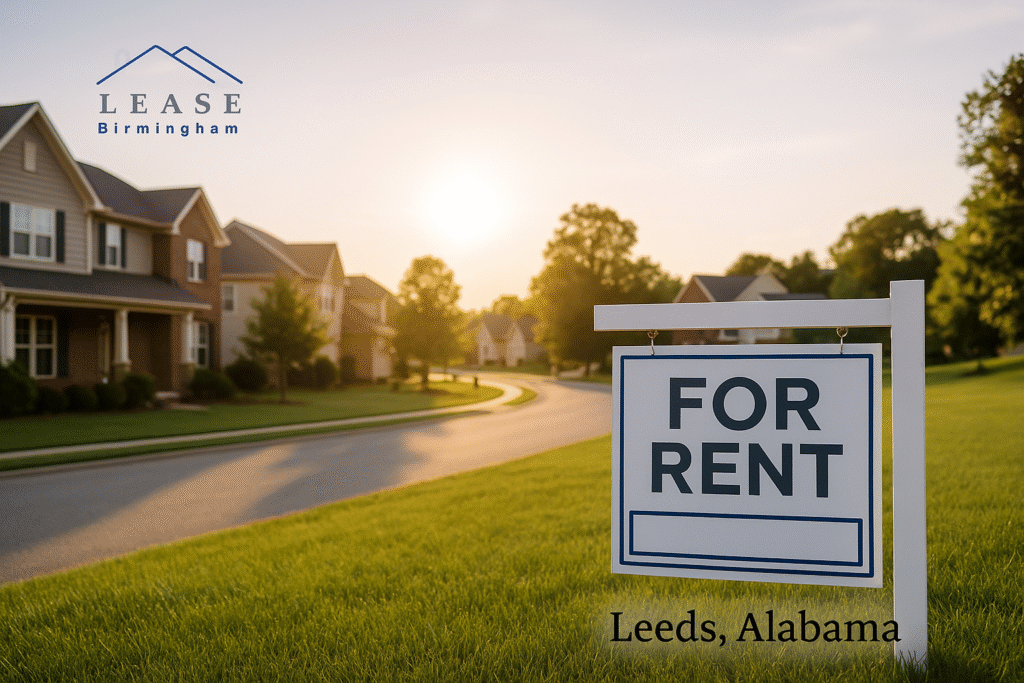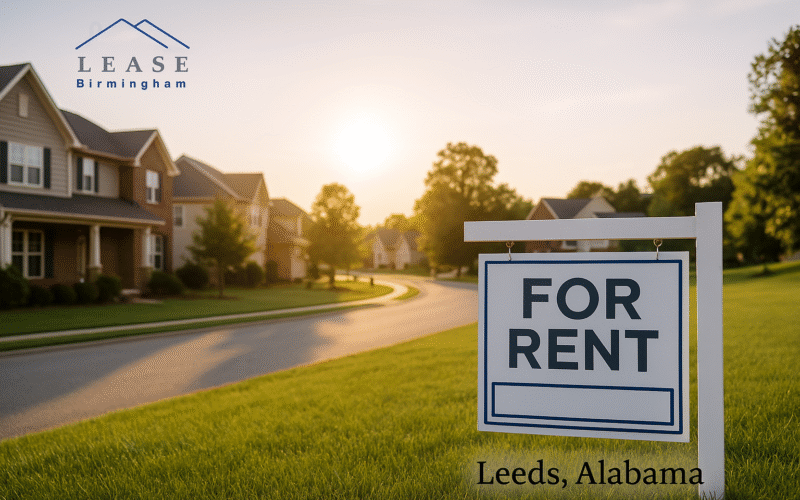Strategies for Property Owners to Maximize Returns Amid Rising Rental Demand in Leeds, Alabama
Introduction
Rental demand in Leeds, Alabama has been increasing due to its location, accessibility, and the shifting preferences of renters throughout the Birmingham metro area. Leeds sits along I-20, providing direct access to both Birmingham and Anniston, which makes it attractive for commuters and residents seeking a small-town environment without sacrificing proximity to urban job centers. The area has also seen new residential and commercial developments, drawing interest from individuals and families looking for more space, affordability, and community engagement than central Birmingham provides. As more people seek out these qualities, the demand for rental properties has grown steadily.
Property owners in Leeds are positioned to benefit from this demand surge, but doing so requires a deliberate and informed approach. The objective of this article is to equip property owners with specific strategies to enhance the profitability and long-term value of their properties. Maximizing returns involves more than simply holding a property and waiting for appreciation. It demands ongoing attention to local market shifts, thoughtful acquisition, pricing strategies, property improvements, and tenant relationships. Leeds presents a variety of opportunities, but capitalizing on them depends on accurate, location-specific decision-making.
This article offers guidance on navigating the current rental environment in Leeds. Each section addresses a different facet of managing and profiting from residential real estate in the area. Property owners will find detailed recommendations for sourcing high-performing properties, setting competitive rents, identifying the most promising neighborhoods, and optimizing tenant retention. Throughout the article, real-world examples and region-specific considerations will help clarify how to translate local rental demand into measurable financial results.
Evaluating the Leeds Rental Landscape
Demand Drivers in Leeds
Leeds has become increasingly attractive due to ongoing shifts in population patterns, economic factors, and internal migration within the Birmingham metropolitan region. Population growth in the area is influenced by residents relocating from denser city neighborhoods to smaller towns that offer both space and convenience. Leeds serves as a natural destination for those seeking proximity to Birmingham while avoiding the higher living costs and congestion of urban centers. This migration has resulted in a steady stream of renters looking for quality housing options that match their budget and lifestyle.
Local employment trends contribute directly to rental demand. Leeds benefits from its proximity to multiple employment corridors, including industrial zones, distribution centers, and medical facilities spread across Jefferson and St. Clair counties. Job availability in these sectors attracts a wide range of renters, including younger workers, middle-income families, and retirees downsizing from homeownership. The variety of job types creates a diverse tenant base, which further stabilizes and sustains rental activity in the area. These dynamics create an environment where rental property owners are consistently presented with new leasing opportunities.
Development limitations in Leeds also play a role in balancing rental supply. Zoning restrictions, availability of undeveloped land, and the pace of new construction impact the overall number of residential units that can be brought to market. In areas where development is slower or more regulated, supply does not always keep up with demand. This imbalance places added pressure on existing rental stock, often leading to increased occupancy rates and reduced vacancy periods. Properties that are well-maintained and appropriately priced in such environments tend to lease quickly, making strategic ownership even more critical.
Types of Properties in Demand
In Leeds, demand trends show a clear distinction between preferences for different types of residential properties. Detached single-family homes are often favored by families seeking privacy, yard space, and a suburban atmosphere. These properties are especially appealing in neighborhoods with good schools and access to parks or shopping centers. In contrast, apartments appeal more to single professionals, couples without children, and older adults looking for simplified living arrangements. This division creates specific demand pockets across property types that vary by neighborhood and tenant demographic.
The rentability of older single-family homes depends largely on their condition, layout, and location. Homes built several decades ago may offer more interior space or larger lots than newer constructions, but often require updates to meet the expectations of today’s renters. Properties with outdated electrical systems, aging HVAC units, or worn finishes can struggle to compete unless upgraded. However, when improvements are made strategically, older homes can outperform newer ones by offering charm, character, and desirable locations that newer subdivisions cannot replicate.
Newer developments, on the other hand, generally offer modern layouts, energy-efficient appliances, and standardized amenities that meet the demands of a broad range of tenants. These properties tend to require less maintenance in the early years and attract tenants who value modern finishes and functionality. However, their appeal may be limited by higher rental rates or less flexible leasing terms. Investors who understand the trade-offs between older and newer properties, and who tailor their offerings to specific renter segments in Leeds, are more likely to maintain high occupancy and maximize return.
Strategic Property Acquisition
Sourcing High-Yield Investment Properties
Finding homes with strong income potential in Leeds begins with narrowing the search to areas where tenant demand remains consistent year-round. Locations near schools, healthcare facilities, industrial parks, and commercial corridors tend to produce more stable leasing patterns. In Leeds, properties near Highway 78 and close to the I-20 corridor often attract tenants due to their accessibility to job centers and shopping. Investment properties in these areas are more likely to maintain occupancy and reduce turnover, which directly contributes to stronger long-term income.
Beyond location, the physical condition and layout of a home influence its rentability and performance as an income-producing asset. Homes that require minimal capital improvement before leasing are typically better positioned for short-term return, but those needing moderate updates can often be acquired at lower prices and repositioned to achieve higher yields after renovations. Buyers evaluating income properties in Leeds should consider floor plans that align with tenant expectations—open kitchens, multiple bathrooms, and storage space are often favored over purely cosmetic features.
When comparing multifamily and single-family properties, investors must weigh income consistency against maintenance demands and tenant preferences. Multifamily properties often deliver higher gross rental income due to multiple leases, making them more resilient to individual tenant turnover. However, they also involve more intensive management and frequent repairs. In contrast, single-family homes typically attract longer-term tenants who treat the property as their own residence, which can lead to reduced wear and lower vacancy rates. In Leeds, both property types can perform well, but the decision depends on the investor’s capital, operational capacity, and rental strategy.
Identifying Growth Zones in Leeds
Neighborhoods in Leeds showing increased leasing activity often exhibit certain physical and social characteristics. Areas experiencing recent infrastructure investment, school renovations, or commercial expansion usually see a corresponding rise in rental demand. Regions near downtown Leeds, where civic and retail improvements have been made, are seeing more interest from tenants seeking convenience and modern amenities. Residential pockets closer to the border of Moody and Irondale offer strategic access to both Jefferson and St. Clair counties, making them attractive to renters commuting in multiple directions.
Tracking long-term appreciation potential requires an evaluation of both current development patterns and historical property value changes. In Leeds, areas near newer subdivisions or those benefiting from ongoing residential infill projects tend to show stronger appreciation over time. These locations often have new construction or renovated homes that raise neighborhood standards and increase surrounding property values. Buyers should monitor building permit activity, local planning commission reports, and infrastructure announcements to determine which zones are likely to continue growing in value.
Other appreciation indicators include rising school performance scores, increasing owner-occupancy rates, and the introduction of national or regional retailers. These signs suggest both private and public investment in the area, which often correlates with upward pressure on property values. In Leeds, neighborhoods that consistently attract new residents and sustain interest from both renters and buyers tend to deliver stronger financial outcomes for property owners. Selecting properties in these zones improves the likelihood of long-term success through both cash flow and asset appreciation.
Setting Competitive Lease Rates
Market-Based Rent Analysis
Establishing the correct lease rate begins with a detailed comparison of similar rental properties within Leeds. Rental pricing must reflect not only the square footage and number of bedrooms, but also the property’s condition, layout, amenities, and proximity to essential services. Properties within the same zip code can have significantly different price points depending on school district boundaries, noise levels, traffic patterns, or access to shopping and employment hubs. Pricing a lease accurately depends on isolating listings with similar features and tracking what tenants are actually paying, not just what landlords are asking.
Lease rates in Leeds also respond to seasonal shifts and fluctuations in demand. In warmer months, particularly late spring and summer, more tenants are actively searching, which can support higher lease rates. In contrast, leasing activity slows during the late fall and winter, especially around the holidays, and properties often sit longer unless prices are adjusted accordingly. Owners who hold firm to high rates during slow seasons risk increased vacancy costs that outweigh any gain from charging premium rents. Seasonally aligned pricing strategies help reduce time on market and stabilize occupancy.
Vacancy duration should influence lease pricing decisions. When a property remains vacant beyond the average turnover period in Leeds, it often signals that pricing is misaligned with market expectations or the home is lacking appeal compared to others in the area. Reducing the lease rate in small increments can prompt renewed interest and create urgency among prospective tenants. Owners who track inquiries, showings, and feedback during the vacancy period gain a clearer picture of where pricing stands in relation to the market. This data, when used in real-time, supports faster leasing and better financial outcomes.
Leveraging Local Data
Effective rent pricing in Leeds relies on a combination of public data, proprietary tools, and rental platforms tailored to the local market. Online tools such as rent estimate calculators and rental listing platforms offer broad overviews of asking prices, but they often miss real-time variables like property upgrades or neighborhood-specific appeal. Property management software that integrates leasing histories, tenant behavior, and maintenance records gives a clearer picture of what similar properties are actually yielding. These tools help owners set lease rates grounded in actual leasing performance rather than generalized assumptions.
Owners in Leeds who rely solely on national rental databases may overlook local metrics that strongly impact pricing. School quality ratings, crime trends, and zoning changes are frequently tied to shifts in rental interest. Properties located near schools undergoing performance improvements or infrastructure investments often experience increased rental activity, pushing lease rates higher. Likewise, homes located in areas with planned retail or transit developments may gain pricing power as those projects progress. These factors are often tracked at the municipal or county level and are essential inputs for local rent modeling.
Another important metric influencing rent decisions in Leeds is the lease-up speed of comparable properties. Monitoring how quickly homes are leased after listing helps determine whether the market can sustain higher rates or if there is downward pressure. Properties that lease within a week at a given price point suggest strong demand, while those that linger for several weeks may indicate overpricing. Combining this metric with other local indicators, such as tenant income profiles and employer expansions, gives property owners a comprehensive view of where their lease rate should fall. The more granular the data, the more accurate the pricing strategy.
Enhancing Property Appeal to Tenants
Modern Upgrades That Add Rental Value
Renovations that generate strong returns in Leeds tend to be those that directly impact functionality, appearance, and energy efficiency. Tenants in this market often prioritize updated kitchens and bathrooms with clean finishes, neutral color palettes, and modern fixtures. Durable flooring such as luxury vinyl plank performs well due to its combination of appearance and resilience. Properties that include these features typically command higher lease rates and see shorter vacancy periods. Enhancements that make a home more livable and visually appealing without requiring extensive structural changes tend to produce the highest return on investment.
Energy-efficient improvements are another category that influences rental value in Leeds. Tenants increasingly pay attention to monthly utility costs, and homes with updated HVAC systems, smart thermostats, and energy-efficient windows often stand out in listings. These features not only appeal to environmentally conscious tenants but also help reduce long-term maintenance issues for owners. When implemented alongside cosmetic upgrades, energy-efficient improvements can push a property into a higher rental tier within its neighborhood. This is particularly useful in Leeds, where utility costs are a frequent consideration during tenant screening.
Over-investment in features that don’t translate into faster leasing or higher rates is a common pitfall. High-end appliances, custom cabinetry, or luxury tile can exceed what the local rental market will support. In Leeds, tenants expect clean, well-maintained properties, but rarely demand the level of finishes found in owner-occupied homes. Installing upscale finishes in neighborhoods where median rents remain moderate may result in extended vacancy periods, as the asking price cannot be supported. Owners must align renovation budgets with expected lease rates and the spending habits of the area’s tenant base.
Staging and Presentation for Rentals
Curb appeal has a direct impact on a prospective tenant’s first impression, and in Leeds, this often determines whether a showing leads to an application. Homes that are freshly landscaped, with trimmed hedges, mowed lawns, and clean entryways, communicate care and quality. Exterior features such as painted shutters, intact gutters, and updated light fixtures help position a property above others in the same price range. In neighborhoods with multiple rentals, exterior presentation often becomes the differentiator that draws early interest.
Interior condition plays a central role in final decision-making. Tenants in Leeds expect homes to be clean, odor-free, and visually inviting. Neutral paint, ample lighting, and decluttered spaces make it easier for potential renters to picture themselves living in the home. Cleanliness and functional layouts often matter more than square footage alone. Properties that show well in-person tend to receive applications faster, especially when paired with competitive lease terms.
Creating standout listings begins with high-quality photography and detailed descriptions that highlight a property’s strengths. Lighting, composition, and angles in photos should be carefully selected to emphasize space and upgrades. Listings should include not only room dimensions but also features such as storage space, fenced yards, or included appliances. In Leeds, where prospective tenants often browse online before scheduling a visit, the digital presentation must convey both value and comfort. The goal is to produce enough interest from the listing to generate immediate inquiries and reduce days on market.
Tenant Screening and Retention Practices
Screening Protocols That Reduce Turnover
Selecting long-term tenants in Leeds requires a structured screening process that prioritizes stability, payment history, and compatibility with lease terms. A thorough review of credit reports, employment verification, and rental history helps identify applicants who are more likely to honor lease commitments. Tenants who demonstrate consistent employment and positive relationships with previous landlords often contribute to longer occupancy periods and fewer disruptions. Screening for longevity involves identifying patterns of reliability rather than focusing solely on income or credit score in isolation.
Screening processes must comply with federal and state fair housing laws, which prohibit discrimination based on protected characteristics. Property owners must develop objective criteria that are applied uniformly across all applicants. These criteria can include minimum income thresholds, acceptable credit scores, and clear eviction histories, but they must be structured to avoid bias. In Leeds, where tenant diversity spans multiple employment sectors and household types, screening systems must be fair, transparent, and well-documented. Any deviation from consistent screening practices can expose owners to legal risk and undermine tenant trust.
Property managers in Leeds often rely on digital platforms that automate and standardize the screening process. These systems aggregate credit data, criminal background checks, and rental histories into comprehensive reports that simplify applicant evaluation. Automated scoring models help ensure decisions are based on pre-set criteria, not subjective judgment. This method reduces inconsistencies and enhances the likelihood of securing tenants who meet performance expectations. Using these tools, owners can make faster leasing decisions while maintaining compliance with fair housing standards.
Strategies to Increase Lease Renewals
Encouraging tenants to renew their leases begins with proactive communication and responsiveness throughout the tenancy. When tenants feel their concerns are addressed quickly and maintenance is handled professionally, they are less likely to search for other housing. Property owners in Leeds who establish reliable communication channels, such as online portals or direct text access to management, often retain tenants longer. Building trust through consistent service increases the chances that tenants will remain in place rather than seek alternatives at the end of a lease term.
Incentives tailored to tenant needs can also boost renewal rates. These may include modest rent discounts for renewing early, property upgrades like carpet cleaning or appliance replacements, or flexible payment dates for long-term residents. Tenants who perceive tangible benefits for staying often see more value in renewing than relocating. In Leeds, where moving costs and relocation logistics can be burdensome for families or working professionals, offering small but meaningful perks can reduce turnover and vacancy expenses.
Lease structuring aligned with tenant expectations further supports renewals. Offering both 12-month and flexible lease terms allows tenants to choose options that fit their employment or family timelines. Including clear renewal procedures and outlining possible rent adjustments in the lease helps tenants plan ahead and avoid surprises. In Leeds, where lease-end uncertainty can lead to unnecessary turnover, transparency and flexibility are important tools for retention. Property owners who use structured lease options and documented communication protocols position themselves to keep reliable tenants longer.
Partnering with Lease Birmingham
How Lease Birmingham Maximizes Property Owner ROI
Lease Birmingham provides a combination of property services tailored to the unique rental landscape in Leeds. These services focus on maximizing income while reducing risk and operational friction. Property owners working with Lease Birmingham benefit from a leasing strategy that emphasizes pricing accuracy, thorough tenant screening, and rapid vacancy turnaround. Lease Birmingham conducts market evaluations to set rates that attract quality tenants without undervaluing the property, ensuring stronger monthly returns.
Maintenance coordination is managed through systems that prioritize both speed and cost control. Lease Birmingham schedules preventive upkeep to reduce emergency repairs and leverages relationships with local contractors to secure timely service at competitive rates. This results in fewer long-term maintenance issues and stronger tenant satisfaction. When properties are maintained consistently, they tend to rent faster and retain tenants longer, directly impacting the bottom line for owners. Lease Birmingham uses these maintenance protocols to reduce vacancy-related losses and extend the life of major systems in each home.
Leasing execution is structured around reducing downtime between tenants. Lease Birmingham uses digital marketing tools, online leasing platforms, and coordinated showings to fill vacancies quickly. The application process is fully digitized, allowing for background checks, lease generation, and deposit handling to occur within a compressed timeline. Vacancy periods are shortened by ensuring each step of the leasing cycle is optimized for speed and accuracy. These operational efficiencies are a core part of the model Lease Birmingham uses for driving higher returns across all properties under management.
What Sets Lease Birmingham Apart in Leeds
The depth of experience Lease Birmingham has within Leeds allows for nuanced decision-making grounded in hyper-local knowledge. Understanding which neighborhoods are gaining tenant interest, what amenities renters value in each subdivision, and how school zoning influences leasing activity allows Lease Birmingham to outperform generalized property management models. This localized focus enables pricing, marketing, and maintenance strategies that align directly with tenant expectations and area-specific trends.
Full-service support extends beyond routine management tasks. Lease Birmingham handles everything from legal compliance and rent collection to capital improvement recommendations and financial reporting. Each property is evaluated through the lens of long-term value, not just current rental performance. This approach helps owners plan strategically, identify investment gaps, and respond to shifts in tenant behavior without losing momentum. Every touchpoint in the management process is designed to reduce owner workload while enhancing the asset’s performance.
Lease Birmingham integrates up-to-date rental market trends into every operational decision. As rental preferences evolve—whether due to economic shifts, population changes, or competitive pressure—Lease Birmingham adapts leasing terms, marketing language, and maintenance standards to meet new expectations. This responsiveness allows properties to remain competitive and profitable, even when the broader market becomes more volatile. Owners working with Lease Birmingham gain a consistent, informed partner that uses Leeds-specific insights to preserve income and asset value over time.
Conclusion
Strengthening rental income in Leeds begins with decisions that reflect local demand, property-specific strengths, and strategic investment. Property owners who want to increase returns must evaluate tenant preferences, pricing trends, and neighborhood performance with precision. Each element—acquisition, upgrades, leasing strategies, and tenant retention—works together to build sustainable rental income. Owners who invest time into understanding how seasonal cycles impact lease pricing, where growth is occurring within Leeds, and which upgrades matter most are positioned to reduce vacancies and increase profitability.
The process of managing a rental property goes beyond securing tenants and collecting rent. Success depends on consistent monitoring of the market, prompt attention to property condition, and responsive interaction with tenants. Owners who integrate data into pricing decisions, adapt to tenant feedback, and address maintenance proactively are more likely to retain tenants and avoid the high costs of turnover. The most effective approach is structured, deliberate, and aligned with the specific patterns of the Leeds rental market.
Lease Birmingham delivers property management that reflects a deep understanding of the Leeds area. Services are based on real conditions, not generic formulas, and the operational systems are built to reduce vacancy, preserve property condition, and ensure legal compliance. Property owners who want professional guidance and execution rooted in local experience can rely on Lease Birmingham to deliver performance aligned with long-term rental goals.
Frequently Asked Questions (FAQs) – Strategies for Property Owners to Maximize Returns Amid Rising Rental Demand in Leeds, Alabama
1. How does population growth in Leeds influence rental property performance?
Population growth in Leeds increases demand for housing, especially among individuals and families relocating from more urban areas. This shift leads to heightened interest in rental homes, particularly in areas with good schools, shopping access, and manageable commutes. Property owners benefit from increased tenant applications, reduced vacancy periods, and more flexibility in lease pricing when demand is strong and inventory is limited.
2. What types of properties are renters currently seeking in Leeds?
Tenants in Leeds are drawn to a variety of housing types depending on their lifestyle. Families tend to prefer single-family homes with outdoor space and multiple bedrooms, while individuals and couples may opt for apartments that require less maintenance. Renters value functionality, location, and affordability over luxury finishes, making mid-tier homes in accessible neighborhoods especially appealing.
3. Where can property owners find high-yield investment homes in Leeds?
High-yield investment properties are often found near major transportation routes like Highway 78 and I-20. Properties located near employment centers, retail corridors, and school zones tend to generate consistent rental income. Neighborhoods with limited new construction but high rental demand offer an advantage due to constrained supply, which can push rental rates higher.
4. What is the difference in return between multifamily and single-family properties?
Multifamily properties often generate higher total rental income by housing multiple tenants under one roof, reducing the impact of a single vacancy. However, they require more maintenance and oversight. Single-family homes tend to attract long-term tenants who may take better care of the property, resulting in lower turnover and maintenance costs. Each property type offers different benefits depending on the owner’s management capacity and investment goals.
5. How should property owners set lease rates in Leeds?
Lease rates should be based on detailed comparisons of similar properties in the same area. Owners must consider location, condition, and included amenities when analyzing rent levels. Seasonal demand shifts also play a role, with higher rents possible during peak leasing months and adjustments necessary during slower periods to avoid extended vacancies.
6. What tools can help with rental pricing decisions?
Online platforms and property management software can assist in comparing current listings and analyzing past lease data. These tools provide visibility into how quickly similar properties are renting and what features are influencing lease rates. Metrics such as leasing speed, tenant income profiles, and property upgrade levels help refine pricing strategies.
7. Which upgrades add the most value for renters in Leeds?
Updates that improve functionality, like modern kitchens, durable flooring, and energy-efficient systems, are favored by tenants. These features enhance comfort while reducing operating costs. Cosmetic upgrades should be balanced with local expectations, as excessive investments in luxury finishes rarely lead to proportionate increases in rent within most Leeds neighborhoods.
8. What presentation techniques make rental homes stand out?
Strong curb appeal, clean interiors, and professional photography are essential for attracting tenants. Listings with detailed descriptions and high-quality visuals receive more interest and lease faster. Tenants in Leeds are more likely to apply when they can clearly see the property’s layout, features, and condition before visiting in person.
9. How can tenant screening reduce turnover?
Thorough tenant screening that includes credit checks, rental history, and employment verification helps identify applicants likely to stay long-term. Fair housing laws must be followed throughout the process. Using standardized, criteria-based screening reduces risk and ensures consistency while improving the chances of securing dependable tenants.
10. What lease renewal strategies are most effective?
Offering incentives such as modest upgrades, rent discounts, or flexible lease terms can encourage tenants to renew. Regular communication and timely maintenance build trust, making tenants more inclined to stay. Structuring leases with clear renewal procedures and aligned terms based on tenant needs helps reduce turnover and stabilize income.




